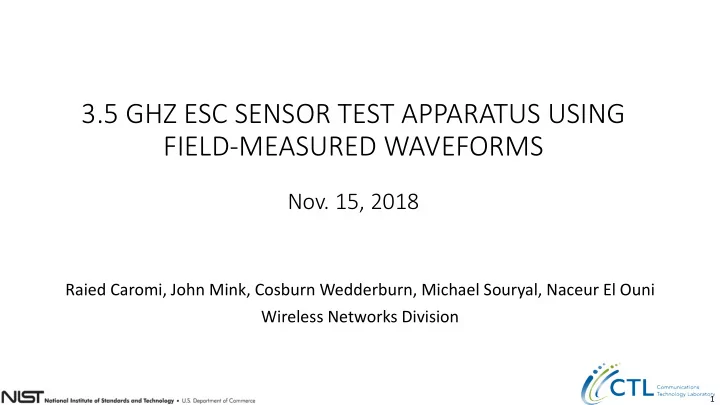

3.5 GHZ ESC SENSOR TEST APPARATUS USING FIELD-MEASURED WAVEFORMS Nov. 15, 2018 Raied Caromi, John Mink, Cosburn Wedderburn, Michael Souryal, Naceur El Ouni Wireless Networks Division 1
Outline • Background • 3.5 GHz NASCTN field-measured waveforms • Waveform generation • ESC test harness • Test waveform examples • Detection example 2
Evaluating the Environmental Sensing Capability • ESC systems are required to: – Detect a federal incumbent signal received at –89 dBm/MHz or higher within 60 s with 99% probability – In the presence of interference from CBSDs and Radar 3 OOB emissions • The material in this presentation is for research purposes and is unrelated to the ongoing certification of CBRS ESC systems. • The technical approach presented here employing field-measured waveforms can be used to: – Develop detection algorithms for ESC sensors with real-world scenarios – Evaluate sensors designed for future bands to be shared 3
Laboratory Evaluation of Commercial ESC Sensors Source: NTIA Technical Memorandum 18-527, “Procedures for Laboratory Testing of Environmental Sensing Capability Sensor Devices” 4
Measurement Site at Fort Story, Virginia Beach • Top of small building • ~20 m elevation • Trees and small buildings to the west 5
NASCTN 3.5 GHz Radar Waveform Measurements 60 60 50 50 40 40 Time (s) Time (s) 30 30 20 20 10 10 0 0 SPN-43 signal without Radar 3 OOB emissions SPN-43 signal embedded in Radar 3 OOB emissions Source: NASCTN Report 2, NIST Technical Note 1954, “3.5 GHz Radar Waveform Capture at Point Loma: Final Test Report” 6
Time Domain Envelopes – Four Timescales ~3 dB fading in power 7
3.5 GHz Waveform Generation and Playback: System Overview Field- measured radar signals ESC test ESC sensor harness under test Field- 3.5 GHz Test measured Waveform waveforms interference Generator signals Radar detection algorithm simulation Synthetic interference signals and/or WGN 8
3.5 GHz Waveform Generator • Preprocessing: – The field-measured radar waveforms (60 s in duration sampled @ 225 MHz) are decimated to 25 MHz – Generate 90-second LTE TDD waveforms • Generation: – Select desired waveform parameters (waveform files, frequency, signal timing, power levels, etc.) – GUI to simplify the selection of the parameters – Automate the generation process for multiple waveform files Source: https://github.com/usnistgov/ESCWaveformGenerator 9
Preview Panel of the Waveform Generator GUI 10
GUI: Waveform Generation Panel • Load all the preview parameters in one place • Provide capability to edit/modify parameters in one place • Generate single or multiple files • Parallel processing to speed up the generation process 11
ESC Test Harness • Controller (Server) • Issues single file at a time to player at a given RF center frequency and RF gain • Waits for Player to finish playing file before issuing next file • Log file Logs playback and notifications with time stamps to a file Control • Player & Record (LabVIEW) Logic • Listens over HTTP for a test (filename & metadata) RF playback ESC sensor RAID • device Converts file from DAT to TDMS (if needed) under test (waveforms) • Plays that file (at specified parameters) ESC Test Harness Overview • Reports to controller when done • Waits for next file Source: https://github.com/usnistgov/RF_Sensor_Test_Harness 12
RF Playback System Overview • VST RF Signal Generator consists of single stage direct conversion I/Q upconverter; upconverts from DC to RF at configured LO frequency (e.g., 3.6 GHz) • VST configured as an AWG for continuous streaming • Read 9 GB IQ file in segments • Configure parameters: • Sampling rate 25 MSa/s • Spectrum Center Frequency 3.6 GHz Analyzer • Digital gain Vector • LabVIEW RF power level configures RAID Signal ESC sensor Drivers (waveforms) Transceiver (DUT) Playback and record functionality Recorder capability 13
RF Waveform Recorder 14
Test Waveform Examples Spectrogram of two LTE signals with fading Spectrogram of in-band radar signal 15
Test Waveform Examples Time-domain plot of a 0.2s portion of the in-band radar signal with co-channel LTE (at the 203s mark of the test) Spectrogram of in-band radar signal with co-channel LTE 16
Test Waveform Examples Spectrogram of adjacent-band interference Spectrogram of in-band radar signal between two fading LTE signals 17
Test Waveform Examples Time-domain plot of a 0.2s portion of the two in-band radar signals with adjacent-band interference (at the 503.6s mark of the test) Spectrogram of two in-band radar signals with adjacent-band interference 18
Detection Example: Tested on VSA Recorded Waveform Response of in-band radar matched filter to the recorded test waveform 19
Summary • An approach and apparatus for quantitatively assessing the performance of a 3.5 GHz ESC sensor using field-measured and synthetically generated waveforms. • Waveforms are generated prior to evaluation for a variety of commercial-federal signal scenarios in which the relative amplitudes and frequency offsets of all signal components can be varied. • Software-controlled instrumentation automates the process by generating a script of RF waveforms and logging sensor detections. It can also record the waveforms as they are seen by the sensor under test for auditing purposes. • Output logs can be processed to generate sensor performance metrics such as detection and false alarm rates. • Example scenarios generated by the apparatus illustrate its flexibility and expected uses. 20
Thank you! Questions? • 3.5 GHz waveform generator, source: https://github.com/usnistgov/ESCWaveformGenerator • RF Sensor Test Harness, source: https://github.com/usnistgov/RF_Sensor_Test_Harness • Detection: Raied Caromi, Michael Souryal, and Wen-Bin Yang, “Detection of incumbent radar in the 3.5 GHz CBRS band,” in Proc. IEEE GlobalSIP , Nov. 2018, to appear. Contacts: Raied Caromi: raied.caromi@nist.gov Cosburn Wedderburn: cosburn.wedderburn@nist.gov Michael Souryal: michael.souryal@nist.gov The material in this presentation is for research purposes and is unrelated to the current, ongoing certification of CBRS ESC systems. Certain commercial equipment, instruments, or materials are identified in this paper in order to specify the experimental procedure adequately. Such identification is not intended to imply recommendation or endorsement by the National Institute of Standards and Technology, nor is it intended to imply that the materials or equipment identified are necessarily the best available for the purpose. 21
Recommend
More recommend